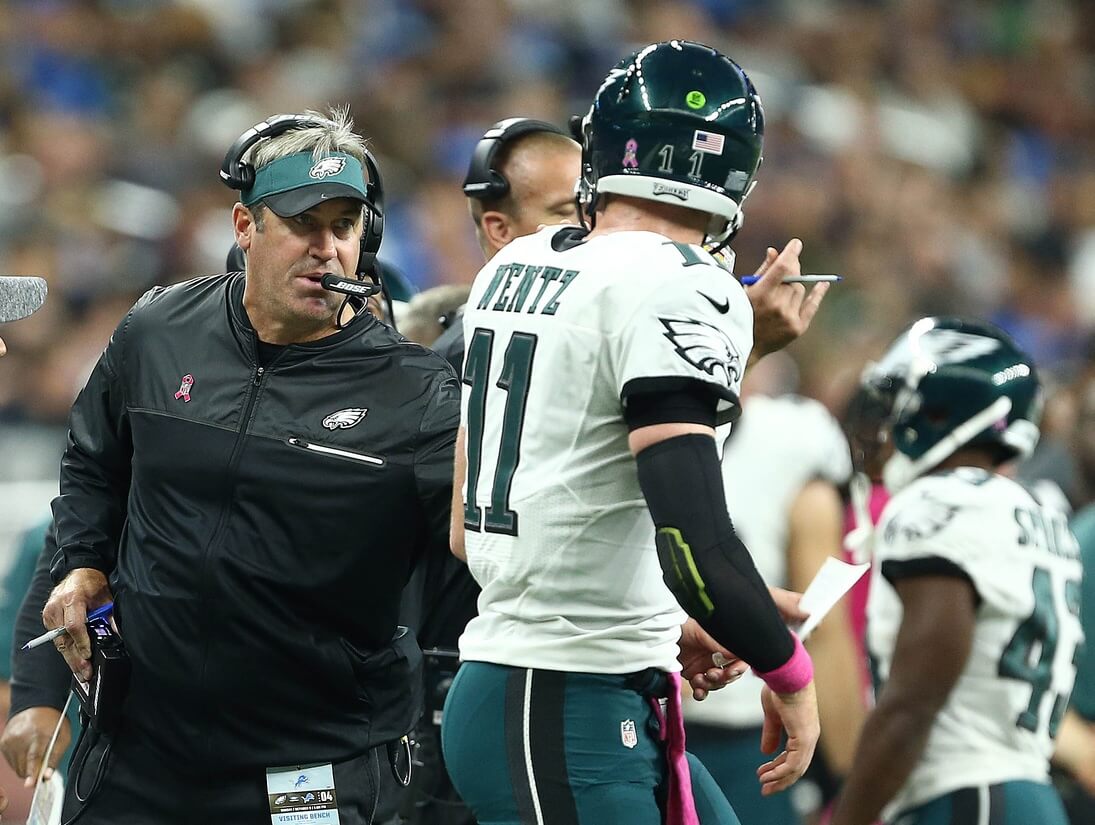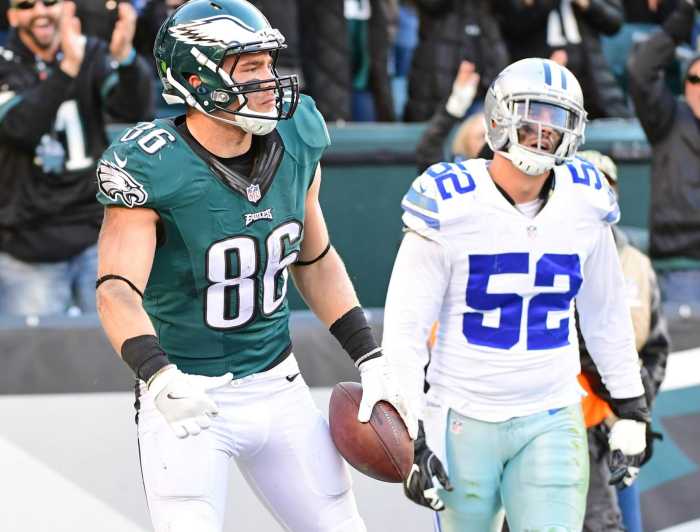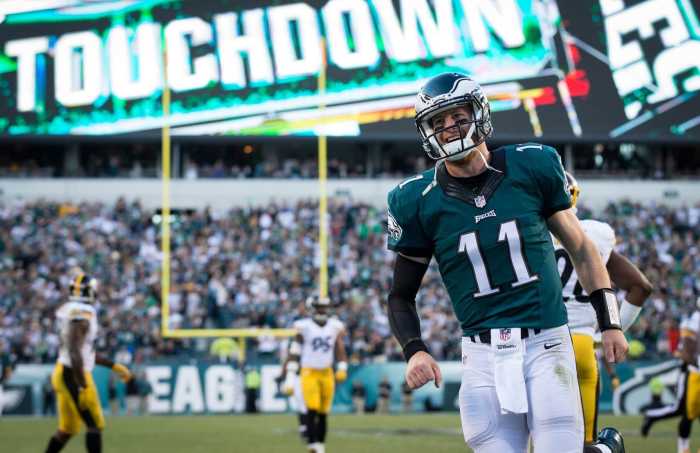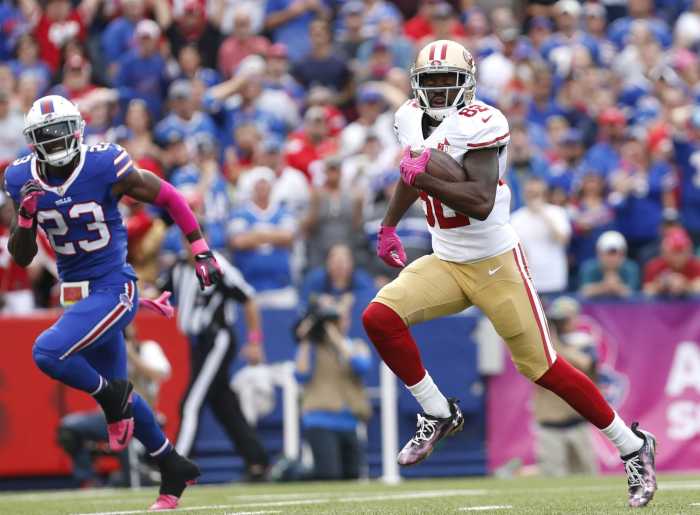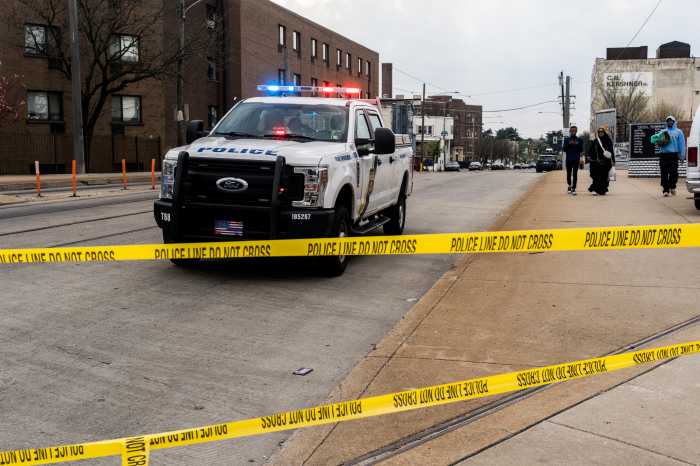Before the 2016 offseason rollercoaster that led to the arrival of Carson Wentz, the Eagles pulled the plug on the Chip Kelly era, and instead sought out a coach who can emotionally connect with the players. After a short interview process, the front office decided that Doug Pederson was the right man to lead the team forward that year, starting a fresh era with a familiar feel. As the eventual rookie year of Carson Wentz progressed, two things became clear for the rookie pairing.
As impressive as the highs would be, there would be rookie walls and problems that the team would need to help them overcome. If we fast forward to the present day after an expected 7-9 season, the Eagles are in much better shape. Alshon Jeffery, Torrey Smith and Chance Warmack will all be playing in Midnight Green next season, giving Carson Wentz an arsenal of weapons on the outside and an extremely deep offensive line to protect him. So while all eyes will naturally fall to the second-year quarterback who blossomed toward the end of his rookie year, the season will be just as important for Doug Pederson.
After an incredibly hot start, the Eagles seemed to stagnate offensively in 2016. An inability to balance the backfield mixed with some questionable play-calls and other hurdles left some overlooked question marks when it came to Doug Pederson’s year. Due to the nature of the season, one which induced an expectation of bumpy roads on the way to growth and development, Pederson, like Wentz, was somewhat relieved of any kind of pressure when the temperature began to rise, and understandably so.
The Eagles are trying to build a sustainable culture and signing a former pupil of Andy Reid who embodied the same emotional style of Football to a five-year contract made perfect sense. The players responded well when faced with adversity and there was a distinct difference between the coaching styles of Chip Kelly and the man now sitting on the throne. But in year two, with an offense poised for a ruthless passing attack, the front office will be very aware of their newly implemented focus on accountability.
Expecting a rookie quarterback to throw 60 passes in a single game is a tall-order..but it’s exactly what was asked of Carson Wentz in the devastating loss to the Bengals. There were times where the Eagles would be in a 3rd & Long situation throughout the year and the play that was called would be an 8-yard curl, relying on the wide receivers to spin off an incoming tackle and pick up the yards after the reception. Whether Pederson lacked the right personnel to create the dynamic west-coast passing attack he envisioned, or whether he was simply, like Wentz, going through the process of finding his footing in a new position, those same errors will stand out boldly if they are repeated in some vein when surrounded by a surplus of talent.
The Eagles had a total of five running backs on the roster throughout the course of 2016, and despite stunning performances like that against the Steelers in which both Kenjon Barner and Wendell Smallwood recorded their first NFL touchdowns, he team failed to balance the offense, which didn’t just hurt the growth of Carson Wentz, but more importantly forced the offense to rely on an inconsistent passing attack. The west-coast offense is one that often adapts a “touchdown or checkdown” mentality.
Jordan Matthews was seen as the primary receiving threat for the Eagles in 2016, but battled injury for the first time in his NFL career, as well as having Defenses scheme to take the slot receiver out of the equation..while Zach Ertz had injury woes of his own early on. Dorial Green-Beckham flashed at times but was otherwise a wildly inconsistent player, dropping a total of 12 passes and piling even more pressure on the shoulders of Nelson Agholor, who would later go on to take a week out from Football in order to address a personal battle.
The Eagles receiving corps was made up of two undrafted rookies alongside the aforementioned and third string tight end Trey Burton, who went on to receive for 327 yards and his first NFL touchdown. The point is, the attack was heavily reliant on a corps that suffered a variety of setbacks.
Those setbacks were apparent in the aggressiveness of the playcalling. While this certainly helped the team at times, who fully trust in the former Kansas City Offensive coordinator, there were others where it stung them. From electing to leave a red hot Caleb Sturgis on the sidelines and instead attempt to go for a risky fourth down, costing the team three crucial points, to some strange calls in big situations and of course the aforementioned problems, Pederson endured a growing curve just as his young quarterback did. And like the North Dakota State product, the foundations are now in place to build on and really use as a reference guide to what worked and what didn’t in 2016.
In 2017, the talent argument shouldn’t be a concern. Alshon Jeffery provides that “star-quality” that the Eagles appear to have been missing and with a mixture of Torrey Smith and Nelson Agholor on the other side, the Eagles should have a a dynamic assault with Ertz and Matthews working over the middle. An array of talent means that the margin for error shrinks..and for Pederson, it means his play-calling has to grow, just as his reputation did.
After the heartbreaking loss to the Bengals, Pederson was able to rally the troops after a tough press conference and light a fire inside the locker room that had not been seen for quite sometime. The team would go on to fight tooth and nail against a Washington team with realistic playoff hopes and battle until the bitter end against Baltimore, a game that ended after a game tying drive from Carson Wentz, his first of his career. Two more revenge wins against NFC East teams would show a complete resurrection in play. The play-calling was smarter, the quarterback play was far more dynamic and the offense appeared to finally balance out.
If Pederson can carry that kind of momentum into 2017, now knowing what his team is capable of and having a firm culture in the locker room, the sky is really the limit for a group simply loaded with talent. But, just like Carson Wentz, it all gets real now. The team are entering the second year of their five year window, and with such a dynamic group of guys on offense, the excuses are now out of the window for both quarterback and coach. It’s time to see what this team is really made of and how competitive they can truly be in an NFC division that is very close to earning the “Beast” reputation once again. When the lights come on, it will be just as exciting, and interesting, to see how Doug Pederson approaches the year from a coaching standpoint, as Carson Wentz does from a playing perspective.
Mandatory Credit: Mike Carter-USA TODAY Sports

